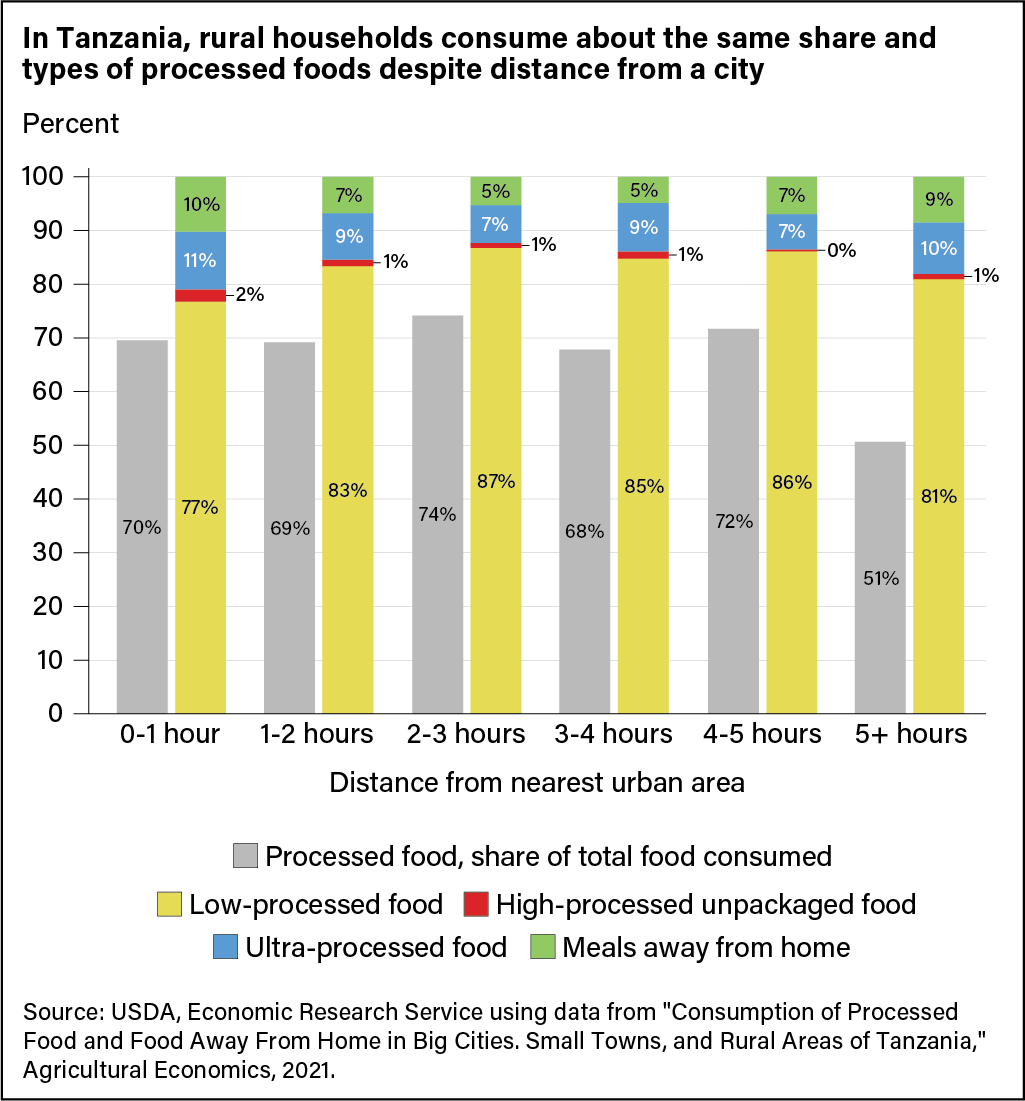
Rural Tanzanians Turn to Processed Food and Meals Away From Home as Incomes Rise and Employment Patterns Shift
- by Christine Sauer
- 10/3/2022
People around the world are shifting away from diets of mostly staple foods and are eating more processed food and meals away from home that can be high in salt, fat, and sugar. For instance, USDA’s Economic Research Service (ERS) reported in 2017 that as incomes rose in developing regions such as Sub-Saharan Africa, people tended to consume more processed foods. This change in eating habits is known as nutrition transition. Combined with more sedentary lifestyles, nutrition transition can lead countries to experience the “double burden of malnutrition.” That is, obesity and under-nutrition may occur at the same time. (For more information, please see ERS’ International Consumer and Food Industry Trends topic page.)
Researchers from ERS and Michigan State University recently studied geographic and demographic patterns of consumption of processed food in one Sub-Saharan African country, Tanzania. This study helps show who is consuming processed food and where, as well as the factors that drive such consumption. It also sheds light on potential dietary changes in other countries experiencing demographic changes similar to those in Tanzania. The researchers used data from Tanzania’s Household Budget Survey, which collected information on, among other things, household members’ employment situation, education, assets, and food consumption. For the food consumption information, the survey relied on a 28-day diary filled out by a household member. Researchers classified each food product by five levels of processing:
- Unprocessed food (such as raw fruits and vegetables, and beans);
- Low-processed food (such as maize flour and milled rice);
- High-processed unpackaged food (such as mandazi, a fried wheat bun similar to a donut);
- High-processed packaged food, also called ultra-processed food (such as cookies, bread, and soft drinks); and
- Meals away from home, which are meals consumed outside the house (such as rice with beans or French fries and eggs consumed at a roadside stall or in a cafeteria).
Researchers also used geographic information to categorize rural households by the driving time, in hours, from the nearest urban area.
The researchers found high shares of processed food (including meals away from home) in total food consumption, even in rural areas of the country. Processed food accounted for an average of 70 percent of the total value of food consumed by rural Tanzanian households, including meals away from home, compared to about 78 percent for urban households. Distance of rural households from a city did not affect the data because the share and type of processed food in the diet remained about the same for rural households, even for households farthest from urban areas. The chart below shows that, aside from a drop-off of total processed food consumed in the most hinterland rural areas, processed food hovers around 70 percent of consumption. The share of low-processed food in total processed food remains around 80 percent to 85 percent in all rural areas. The most highly processed categories—ultra-processed food and meals away from home—make up more than 10 percent of the diet in all rural categories. Further analysis suggests that key drivers of processed food consumption include higher incomes and the time women spend working away from the farm.
The results obtained from Tanzania echo ERS research on U.S. eating patterns. A report from 2018 showed that higher U.S. household incomes and greater time constraints (for example, because of higher participation of women in the workforce) are correlated with the purchase of highly processed food and meals eaten away from home. Taken together, these findings suggest that in Tanzania, as in the United States, increasing incomes and changing employment patterns are associated with higher consumption of ultra-processed food and meals eaten away from home, raising concerns about obesity and the so-called double burden of malnutrition.
This article is drawn from:
- Rahkovsky, I., Jo, Y. & Carlson, A. (2018). Consumers Balance Time and Money in Purchasing Convenience Foods. U.S. Department of Agriculture, Economic Research Service. ERR-251.
- Sauer, C.M., Reardon, T., Tschirley, D., Liverpool-Tasie, S., Awokuse, T., Alphonce, R., Ndyetabula, D. & Waized, B. (2021). “Consumption of Processed Food and Food Away From Home in Big Cities, Small Towns, and Rural Areas of Tanzania”. Agricultural Economics. doi: 10.1111/agec.12652.
You may also like:
- Okrent, A. & Kumcu, A. (2016). U.S. Households’ Demand for Convenience Foods. U.S. Department of Agriculture, Economic Research Service. ERR-211.
- Saksena, M., Okrent, A., Anekwe, T.D., Cho, C., Dicken, C., Effland, A., Elitzak, H., Guthrie, J., Hamrick, K., Jo, Y., Lin, B., Mancino, L., McLaughlin, P.W., Rahkovsky, I., Ralston, K., Smith, T.A., Stewart, H., Todd, J.E., Tuttle, C. & Hyman, J. (2018). America’s Eating Habits: Food Away From Home. U.S. Department of Agriculture, Economic Research Service. EIB-196.


